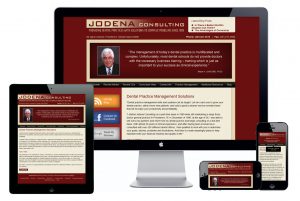Responsive Design Websites
December 27, 2012

According to Forrester Research, the growth in mobile demand is explosive. In the United States alone, the forecast is for 159 million smart phones to be in use by 2015. More people use smart phones for Internet search than traditional Web (full screen laptops and desktops with browsers). The problem is that your dental website is almost unreadable on a mobile device. So the forward thinking strategy until now had been to develop a separate mobile website that better fits a smaller screen.
Responsive design is a new technique that enables web pages to dynamically adjust depending on the device being used and the amount of screen real estate available. TNT Dental is the only company that I know of that is building responsive design websites in the dental space right now.
An adaptive website thus replaces the need for a separate mobile version of your website. Your TNT website morphs and optimizes with the device you view it on. This enables your mobile site to load faster without the need of a separate site or application. The website identifies the device and its capabilities and decides what is best to load, optimize and change. Because it responds to the device you are using, it is smarter than your average website.
Unlike traditional mobile versions of websites which can be somewhat drab by comparison, the colors and graphics that are part of your regular website are retained and used, so all the work that has gone into creating your unique website are carried throughout the responsive mobile version of your site. It also includes all the optimization from your website which means that all of your on-page SEO remains in place as well.
Since a picture is worth a thousand words, my good friends at TNT have created two screen shots to demonstrate how this works. The first shows my website as it would appear on a laptop or desktop computer, an iPad, and a smart phone. In fact the version on the smart phone shows the difference when held horizontally or vertically, demonstrating the ability of responsive design to adapt and optimize to the screen. The second screen shot shows my old (pre-responsive design) basic two page mobile website compared to the new responsive design version.
I think this is SO amazing. You might want to give TNT a call and see if this could work for you. Tim Healy can be reached at 877-868-4932.
Is There A Better Win/Win Situation Out There?
December 12, 2012
According to the American Dental Association, two or more applications of fluoride varnish per year are effective in preventing caries in patients identified as high or moderate risk. Why is it then that so few practices are aggressively promoting adult fluoride treatments? There seems to be a major misconception by your patients–and unfortunately by many dentists–that fluoride is only beneficial when the teeth are developing, that there is no sustained benefit from fluoride, and that fluoride treatments are just for kids. I recently attended a fabulous three-hour seminar presented by 3M ESPE on CAMBRA. That is the acronym for caries management by risk assessment. Here is what I learned.
1. An actively promoted program is of great benefit to your patients, and it represents a really, really significant revenue stream to the practice through the dispensing of fluoride toothpaste and fluoride varnish treatments.
2. The hygiene department must be supported by the doctor and all staff regarding the importance of risk prevention. Every team member needs to be on board and committed to the program.
3. Patients need to be educated to understand that just treating cavities will NOT prevent future disease.
4. A well-designed, simple, one page caries risk assessment form is essential to success. It is metaphorically similar to a blood pressure cuff at a medical exam. Every time you see your physician, you have your blood pressure taken as part of an assessment of your overall health. So the risk assessment form for caries should be used for every patient visit in hygiene.
I have created a form for your use. You can download the form and personalize it with your practice name. I am also suggesting that you watch this brief video that 3M provides on the application of fluoride varnish. I am also including another brief video that discusses the dispensing of fluoride toothpaste in your office.
This seminar, attended by dentists and hygienists, was a wake-up call for me. As part of the program, we all had to do a self-assessment of our risk for caries. In my case, I am 72 years old, I have significant recession with exposed root surfaces, my mouth is heavily restored with fillings and crowns, and I wear a night guard which causes dry mouth. I am at high risk! I should be receiving fluoride varnish at least twice a year, and the risk assessment form graphically illustrates this fact!
The national average fee for fluoride varnish is about $35. More and more insurance companies are covering this procedure because they recognize the value of prevention. You should be aware that as of January 2013, ADA codes 1203 (child) and 1204 (adult) topical application of fluoride (not varnish) will be combined to code 1208. Code 1206 is now and will continue to be application of fluoride varnish for moderate or high risk patients. Insurance or no insurance – if patients understand the value, they will buy – it’s that simple.
Establishing an aggressive evidence-based carries prevention program should not be that difficult. Please make it one of your resolutions for 2013.

